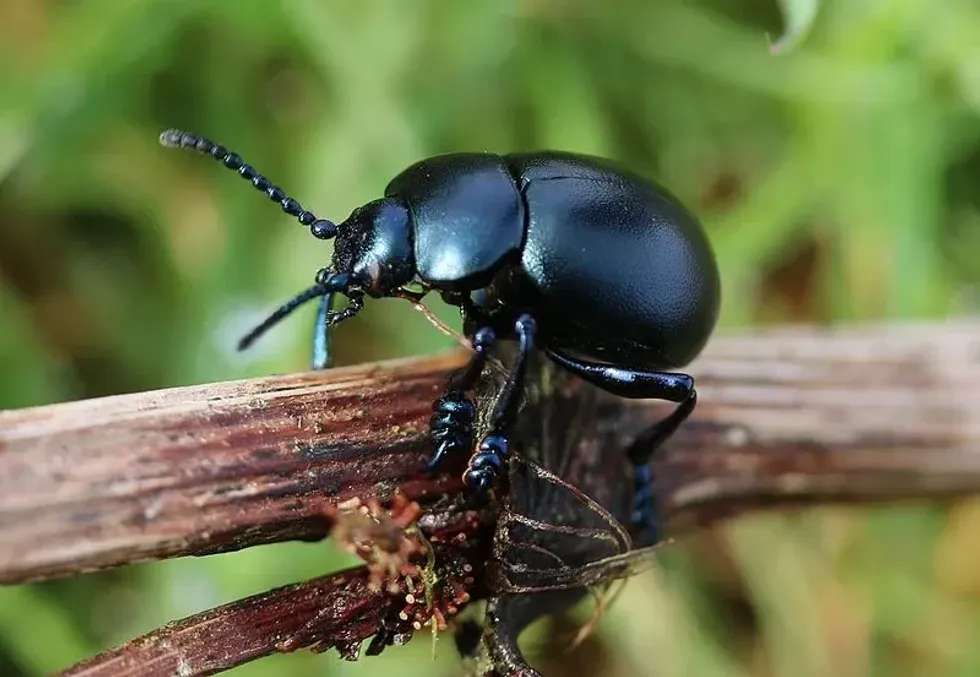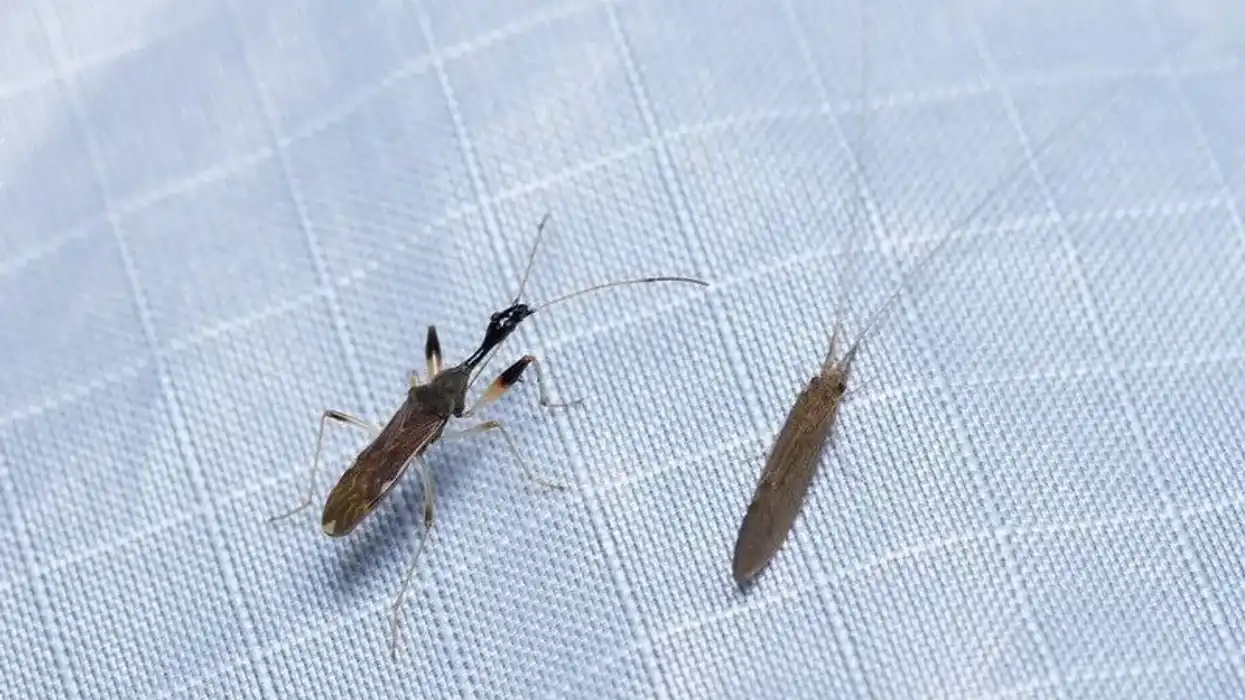Timarcha tenebricosa, with the common name bloody-nosed beetles, is one of the most commonly found leaf beetles that are endemic to Europe. Their common name refers to its ability to produce a bright blood-like haemolymph when feeling threatened by its predators.
This defensive behavior ensures that predators cannot cause any harm to them. The blood-red fluid is foul-smelling and is produced by rupturing the thin membrane inside the beetle's mouth when they feel scared or threatened. The fluid comes out in large drops and is extremely pungent.
This species has a black body with a metallic blue sheen. Their body is curved and their antennae are well-segmented. These beetles can be found in grassland regions and hedgerows.
They are monophagous and feed on tender leaves and stems of bedstraws. This species is harmless to humans but is messy to handle. Their reflex bleeding phenomenon makes them a very intriguing insect to read about.
Keep reading to find out more fascinating facts about this flightless beetle. To learn about other species, check out Japanese beetle facts and whirligig beetle facts.
Bloody-Nosed Beetle Interesting Facts
What type of animal is a bloody-nosed beetle?
A bloody-nosed beetle (Timarcha tenebricosa) is a type of large, round beetle found in grasslands.
What class of animal does a bloody-nosed beetle belong to?
The bloody-nosed beetle (Timarcha tenebricosa) belongs to class Insecta, order Coleoptera, and family Chrysomelidae.
How many bloody-nosed beetles are there in the world?
The exact number of this species living in the world is unknown.
Where does a bloody-nosed beetle live?
The bloody-nosed beetle can be found in large numbers in Britain, Ireland, and southern and Central Europe.
What is a bloody-nosed beetle's habitat?
The bloody-nosed beetle can generally be found in grassland regions, hedgerows, and heathland during the months of spring and summer.
Who do bloody-nosed beetles live with?
Beetles generally lead solitary lives.
How long does a bloody-nosed beetle live?
More studies need to be conducted to determine the exact lifespan of a bloody-nosed beetle. They have been reported to live up to an age of 15 months.
How do they reproduce?
The mating period starts from the late spring and summer season and extends well into fall months. Oviposition begins in the spring and bloody-nosed beetle eggs are laid on the host plant.
At times, these eggs can even be laid in small batches. The eggs are usually covered with leaves or plant debris.
A female bloody-nosed beetle can lay about 200 eggs during the spring and the summer season. After the eggs are laid, two to three weeks later the bloody-nosed beetle larvae emerge and start developing while feeding on the host plant.
Within five to eight weeks, the larvae are fully grown. Pupation mostly occurs in the month of June and adult bloody-nosed beetles emerge in another three to four weeks.
What is their conservation status?
The bloody-nosed beetle (Timarcha tenebricosa) is Not Evaluated in the International Union for Conservation of Nature or the IUCN Red List. However, they have been listed as common in Britain, Ireland, and Europe.
Bloody-Nosed Beetle Fun Facts
What do bloody-nosed beetles look like?
The adult beetle is black in color throughout its body and has a bluish sheen. Their bodies appear to be domed like a Hister beetle and green scarab beetle. Their wingcases are fused together and finely punctuated. The beetle also has well-segmented thick antennae.
How cute are they?
Adults with their all-black bodies appear to be quite scary and intimidating. These beetles do not appear to be cute at first glance, unlike tiger beetle.
How do they communicate?
Little is known about the communication patterns of bloody-nosed beetles. Beetles, in general, are known to communicate with each other through the secretion of chemicals. They, at times, also make sounds and vibrations.
How big is a bloody-nosed beetle?
The bloody-nosed beetle's body length is about 0.6-0.8 in (15-20 mm). It is somewhat smaller than a ten-lined June beetle.
How fast can a bloody-nosed beetle fly?
Unlike some beetles who have the ability to fly, bloody-nosed beetles are flightless.
How much does a bloody-nosed beetle weigh?
The exact weight of the bloody-nosed beetle is not known.
What are the male and female names of the species?
There are no unique names to identify male and female bloody-nosed beetles.
What would you call a baby bloody-nosed beetle?
A baby beetle can be referred to as a grub or a larva depending on the life stage it is in. The bloody-nosed beetle larvae appear to be bloated-looking and have deep folds between their abdominal segments. The larvae, like the adults, are black in color but have a distinct blue metallic sheen on their bodies.
What do they eat?
Most beetles of this species emerge during the month of April to feed. Adults feed on the stems and foliage of host plants. Bloody-nosed beetles also consume terminal shoots.
Galium or bedstraws is the most common host plant for these beetles. Other host plants include lady's bedstraw, fen bedstraw, common madder, and hedge bedstraw. The larvae can be seen hanging from their host plants and feeding on them.
Are they poisonous?
This species can be dangerous to their predators but fortunately are not poisonous and do not cause any harm to human beings.
Would they make a good pet?
This beetle species is not commonly kept as pets.
Did you know...
These beetles are flightless and move at a very slow speed on the ground, mostly during the night.
The phenomenon of secreting blood-red liquid through their mouth as a defense mechanism against predators can also be observed in ladybugs.
How many eggs do bloody-nosed beetles lay?
Female beetles of this species can lay more than 200 eggs during the spring and the summer season. Beetle eggs are large in size and are tawny-colored.
Females do this over a long period so that with the two overlapping generations, all the life stages are present over these long periods. A shallow cell is constructed from the soil where secretions and pupation occurs.
Is the bloody-nosed beetle a leaf beetle?
This beetle species is a leaf beetle and among the largest leaf beetles species found in the United Kingdom. This beetle gets its name due to its defense mechanism of producing a foul-smelling, blood-red fluid called haemolymph when threatened by predators.
When they feel threatened, they end up rupturing the thin membranes present inside their mouth. The bright red fluid secreted by this flightless beetle is harmless to humans but causes harm to predators.
Here at Kidadl, we have carefully created lots of interesting family-friendly animal facts for everyone to discover! Learn more about some other arthropods from our masked hunter facts and bed bug facts pages.
You can even occupy yourself at home by coloring in one of our free printable beetle coloring pages.










